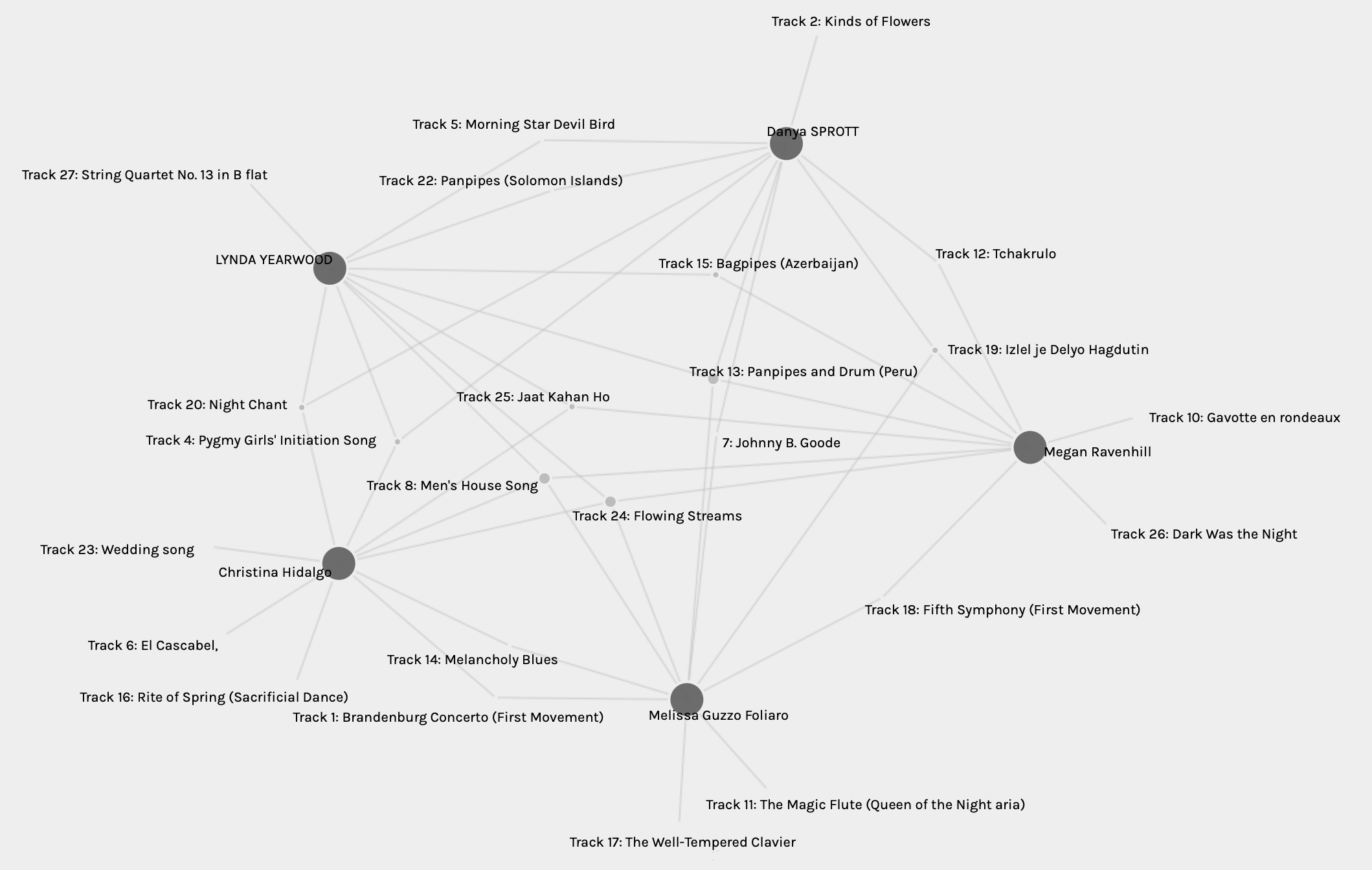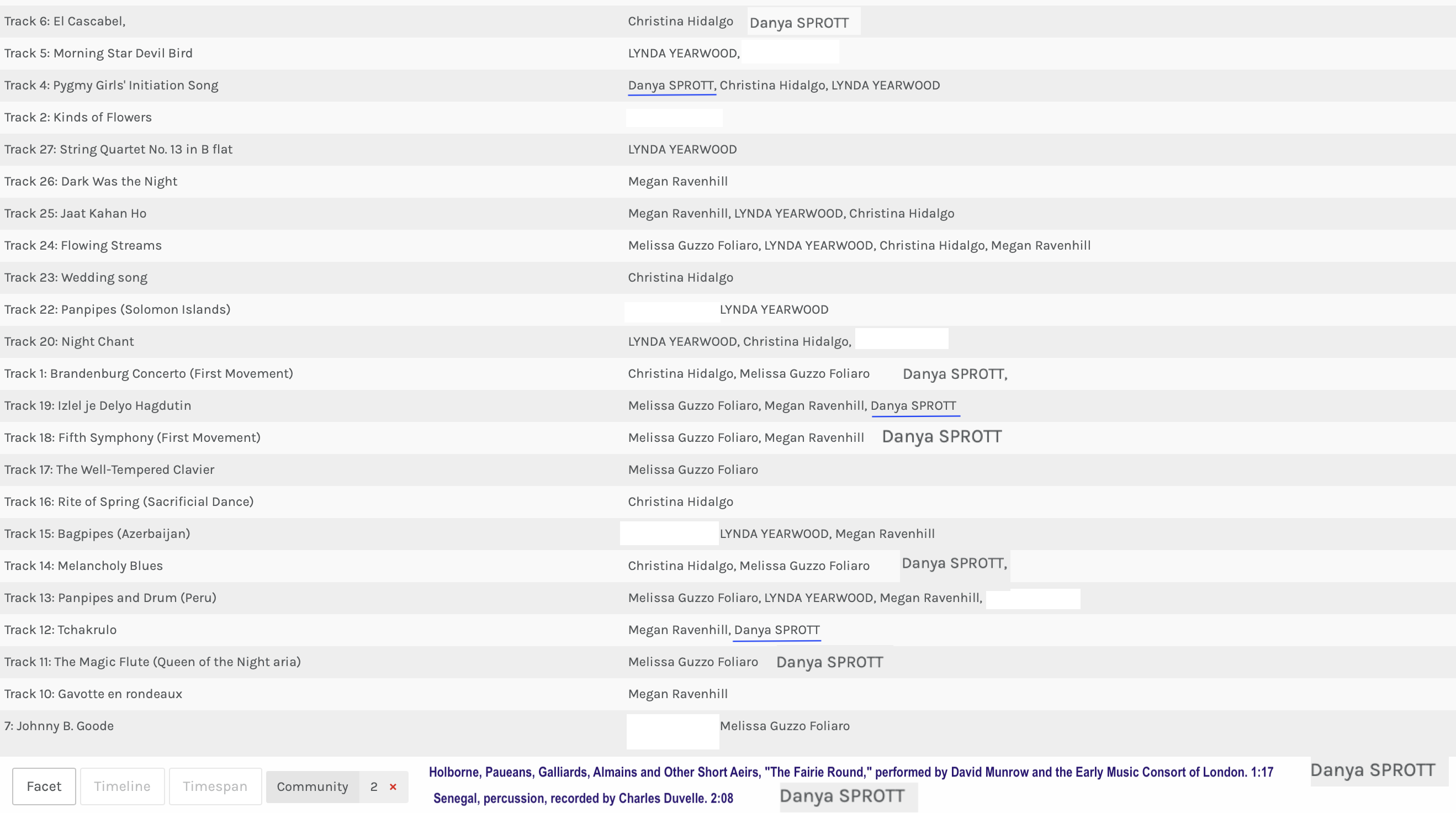Network assignment

At first glance, I was intrigued to see the similarities and differences of the song choices between those the algorithm grouped me with and myself. There were quite a few songs that were only chosen by one of us and two songs were not represented at all. Which meant that all five of us had not chosen those songs.^
To explore some of these similarities and differences, I looked at my group members’ blog posts for task eight to see if we had any similar criteria when choosing our songs.
Christina – considering instruments, rhythm, and musical variety. Balance between vocal and no vocals and between male and female vocalists. Cultural diversity was a variety, removing euro-centric and western songs.
Melissa – selected songs that spoke to them and described how they did.
Lynda – wanted to represent a cross-section of culture and geography. Correcting any euro-centric bias.
Megan – popularity, emotional impact, and cultural diversity. Wanting to represent different geographical areas.
Danya – variety of music without considering geography. Trying to correct for biases by limiting classical music and popular music.
 Both Christina and I wanted to represent musical variety and may of us tried to correct our biases. I had not considered Melissa’s criteria of selecting songs that trigger meaning when listening to them. In one way or another, we all tried to represent a diverse selection of songs either culturally, geographically, or musically.
Both Christina and I wanted to represent musical variety and may of us tried to correct our biases. I had not considered Melissa’s criteria of selecting songs that trigger meaning when listening to them. In one way or another, we all tried to represent a diverse selection of songs either culturally, geographically, or musically.
After spending quite some time observing the graph and moving some of the nodes around, I decided to look at the different tables as they offer a different means of interpreting the data. Here, I quickly found out that my songs were not correctly displayed. As impressive as algorithms can be (Code.org, 2017), human error sometimes has a way of sneaking in. I am assuming that I must have selected the wrong songs in the quiz last week. Below is a picture of the table of songs and who they were selected by. Alongside are my list of 10 songs I shared on my blog for task eight.

- Bach, Brandenburg Concerto No. 2 in F. First Movement, Munich Bach Orchestra, Karl Richter, conductor. 4:40
- Senegal, percussion, recorded by Charles Duvelle. 2:08
- Zaire, Pygmy girls’ initiation song, recorded by Colin Turnbull. 0:56
- Mexico, “El Cascabel,” performed by Lorenzo Barcelata and the Mariachi México. 3:14
- Mozart, The Magic Flute, Queen of the Night aria, no. 14. Edda Moser, soprano. Bavarian State Opera, Munich, Wolfgang Sawallisch, conductor. 2:55
- Georgian S.S.R., chorus, “Tchakrulo,” collected by Radio Moscow. 2:18
- “Melancholy Blues,” performed by Louis Armstrong and his Hot Seven. 3:05
- Beethoven, Fifth Symphony, First Movement, the Philharmonia Orchestra, Otto Klemperer, conductor. 7:20
- Bulgaria, “Izlel je Delyo Hagdutin,” sung by Valya Balkanska. 4:59
- Holborne, Paueans, Galliards, Almains and Other Short Aeirs, “The Fairie Round,” performed by David Munrow and the Early Music Consort of London. 1:17
I decided to see how the results might have differed if this mistake had not been made.
Three of the songs would have become a single selection (tracks five, 22, and seven), one track would have not been selected at all (track two), and two tracks that had previously been unselected would now be selected (The Fairie Round, and the Senegal percussions).
If I were to ignore my error and just take a look at the given table and graph, now knowing our criteria for selecting our songs, I would see that we all had similarities in our selection process. The only stand-alone criteria being the one of how a song makes one feel. Several of us mentioned biases when it comes to our culture or western/euro-centric influences, but it would be interesting to see data showing if our cultural backgrounds had any significance in our selection of songs. Perhaps selecting which songs we were already familiar with and whether that caused us to select it over one we hadn’t heard. Or, if the fact that we were familiar with that song encouraged us not to select it. I was thinking about how a lot of us tried to correct our own biases, but, perhaps in doing so, we might have been playing into them as well.
Many of us explained why we chose the songs we did, but we did not often mention why we did not select the ones omitted from our lists. Some of us gave a brief explanation, but perhaps having an option to write one word explaining why we did not select it would show a pattern when looking at all of the words next to the songs the whole group omitted. Perhaps I do not see it, but I do not believe that the reasons for the ‘null’ choices are reflected or interpreted in the data. These song selections are very personal with everyone chosing their own criteria. This is very subjective, so I believe that to be able to get more out of the graph and tables, we would need to be able to include more data.
It is impressive that there are so many algorithms focusing on every facet of our connectivity. Not just to ensure relevancy while we search and explore, but also to correct human error and remove fake pages (Code.org, 2017). For example, when you type something into Google, and it says ‘Did you mean…’ offering the correct spelling. It is insane that these algorithms can use a form of artificial intelligence to best find the information we are searching for. However, they might not always be as accurate as we may think as they may include their own biases or errors (Rainie & Anderson, 2017).
References
Code.org (2017, June 14). The internet: How search works [Video]. YouTube. https://www.youtube.com/watch?v=LVV_93mBfSU&t=9s
Rainie, L., & Anderson, J. (2017, February 8). Code-dependent: Pros and cons of the algorithm age. Pew Research Center. https://www.pewresearch.org/internet/2017/02/08/code-dependent-pros-and-cons-of-the-algorithm-age/
